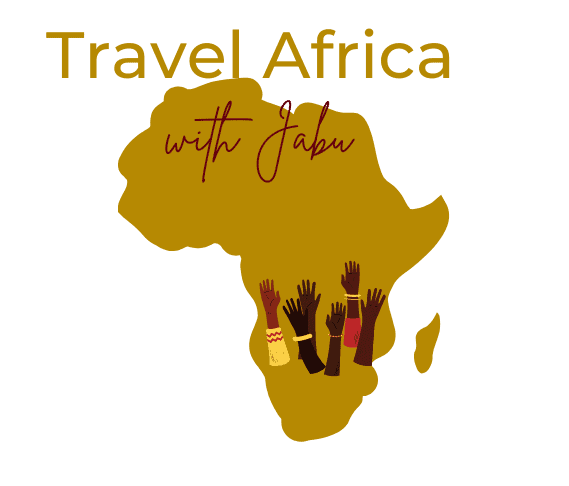Zimbabwe is one of the most beautiful countries in Africa, and definitely, the one to travel to if you want to experience amazing wildlife, diverse landscapes, as well as many rich cultural sites. In this Zimbabwe travel guide, we’ll cover all the things you need to know about travelling to the country so that you enjoy your Zimbabwean adventure.
Zimbabwe is a landlocked country in Southern Africa. It is located on the southern tip of Africa. It borders Zambia and Mozambique to the north, Botswana to the west and south, and South Africa (at its northeastern point) to the south, east and northeast. The Republic of Zimbabwe has an area of 390 310 square kilometres (150 000 square miles).
The capital city Harare has a population of 2 million people while Bulawayo has 1 million people living there.
Languages: English, Shona and isiNdebele
Currency: Zimbabwean Dollar
Religion: Predominantly Christianity; indigenous beliefs and Islam
Time Zone: GMT +2
Top five things to do in Zimbabwe
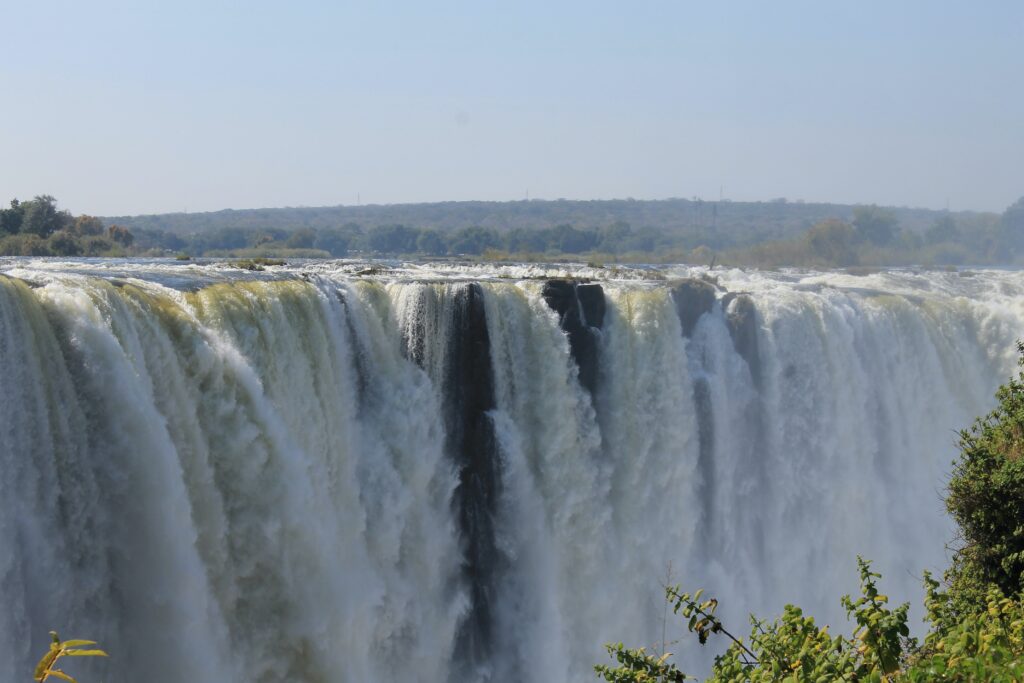
- Victoria Falls are the most iconic landmark in Zimbabwe, and for good reason—the falls are massive, and beautiful. There’s no way to capture their true beauty in a photo. A trip here is an absolute must!
- Great Zimbabwe is one of Southern Africa’s greatest archaeological sites. It was built by the ancestors of today’s Shona people over 1 000 years ago, therefore, making it one of the continent’s oldest structures and certainly worth visiting.
- Lake Kariba is home to some incredible wildlife—including hippos! The lake is also surrounded by some stunning scenery that makes it an interesting place for travellers who like exploring their surroundings as well as seeing animals up close and personal.
- Chimanimani National Park has an amazing array of birds (more than 500 species) which makes this park perfect for bird lovers! There are also various other animals living here too such as giraffes and elephants so don’t forget your binoculars when visiting this special place!
- Hwange National Park boasts some pretty spectacular scenery with large baobab trees dotted across its landscape; however what really sets Hwange apart from other parks around Zimbabwe (and Africa at large) are its elephants — there are thousands living throughout this reserve which makes it quite difficult not to see them roaming around freely without any fences separating them from visitors.
Other things to see and do in Zimbabwe
Harare
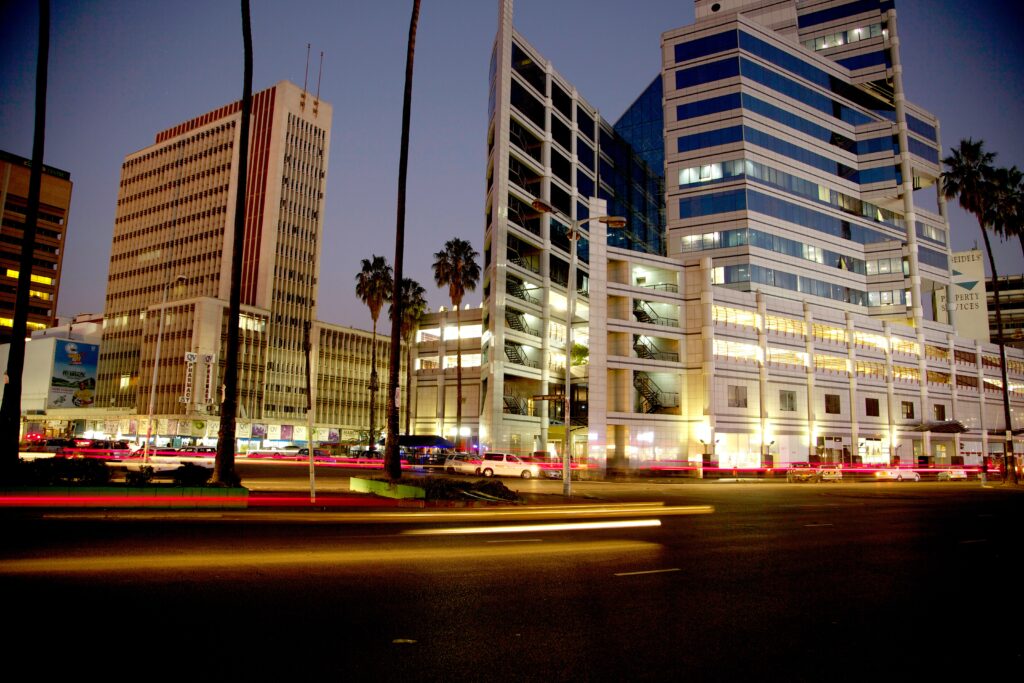
Harare, the capital city of Zimbabwe, is located in the south of the country. The city is named after a Shona Chief, “the one who never sleeps”. On a hill in the city burns the flame of perpetual independence where once the Union Jack fluttered. Harare is usually your first port of call into the country and a great place to start your Zimbabwe expedition as it is home to a number of attractions. These include:
- The National Gallery of Zimbabwe: a visual representation of the country’s heritage showcasing acclaimed artworks. The outdoor sculpture garden displays the distinctive Shona style of sculpture from polished soapstone.
- Chapungu Kraal just outside of Harare is a centre where you can meet the sculptors.
- Mbare Musika Market: a vibrant colourful scene located in one of the country’s oldest townships. The communities sell their food products here as well as trade souvenirs and curios.
- Mukuvisi Woodlands for a horseback safari or a picnic on a platform above the watering hole to view the small game.
- Lake Chivero just outside Harare is a watersports playground and a game reserve offering sightings of giraffes and antelopes.
- Manyame Recreational Park for fishing the favoured African salmon and camping over weekends.
- A lively nightlife
Bulawayo
Bulawayo means “the one to be killed” in one of the country’s official languages, isiNdebele. The city was founded by King Lobengula, son of King Mzilikazi who founded the Mthwakazi Kingdom, now present-day Matebeleland. King Mzilikazi, eager for his own kingdom defied King Shaka and moved his warriors and growing nation northwards into what is now Zimbabwe.
Things to do in Bulawayo
When I was in high school, to get home I had to board my bus from the city hall which was where the Jairos Jiri Craft Shop was located then. It was and still is a celebrated tourist haunt where you can browse the largest selection of arts and crafts in the country. Choose from batik, leather goods, crocheted tablecloths and bedspreads, beadwork, baskets, and soapstone carvings. The crafts are produced by disabled and blind persons and the association has outlets across the country.
You can’t escape Centenary Park or Central Park when you’re in Bulawayo as the two are on either side of the main road in the city. You’ll find an aviary, botanical gardens, the Bulawayo theatre, and the National History Museum.
The museum was founded in 1901 and houses the largest indigenous mammal collection in southern Africa. It also accommodates the second-largest mounted elephant in the world. You’ll spend hours here exploring the prehistoric man exhibit and the displays of local culture.
Other interesting places to explore in Bulawayo are the:
Railway Museum
Chipangali Wildlife Orphanage and Research Centre
Mzilikazi Arts and crafts Centre
Amakhosi Theatre Company
Ivory Kraal
Eastern Highlands
The Eastern Highlands are a 300km mountain range that runs parallel to the Mozambican border. This area is one of the most scenic and iconic places in Zimbabwe home to pine forest and trout lakes, yellowed trees, and mountain shrubs. Unlike the hot Lowveld favourable to safari pursuits, the Eastern Highlands are suited to hiking and more laidback activities like horse riding, fishing, and hot beverages in front of a log fire. The Eastern Highlands is made up of three areas – the Nyanga Highlands in the north, the Bvumba Mountains in the centre, and the Chimanimani Mountains in the south
Highlights of the Eastern Highlands include:
Mutare which is the capital of Manicaland province. This is a good place to stock up on groceries and other refreshments on your way to Mozambique or the surrounding Bvumba mountains. If you do spend a day or two there take time out to visit the Cecil Top Nature Reserve or the La Rochelle Botanical Gardens.
The Bvumba Mountains which hem in the city of Mutare. Along the farm, roads are crafted into an arts and crafts route where you can buy artisanal goods. The Bvumba National Botanical Garden, 200 hectares of fine lawns and wilderness are also worthy of a day’s excursion. The high points offer great views over Mozambique and an ornamental lake. Golfers can stay at the leopard Rock Hotel which is also a birdwatcher’s delight.
Visitors to these parts are also enthralled by Nyanga National Park and Chimanimani National Park.
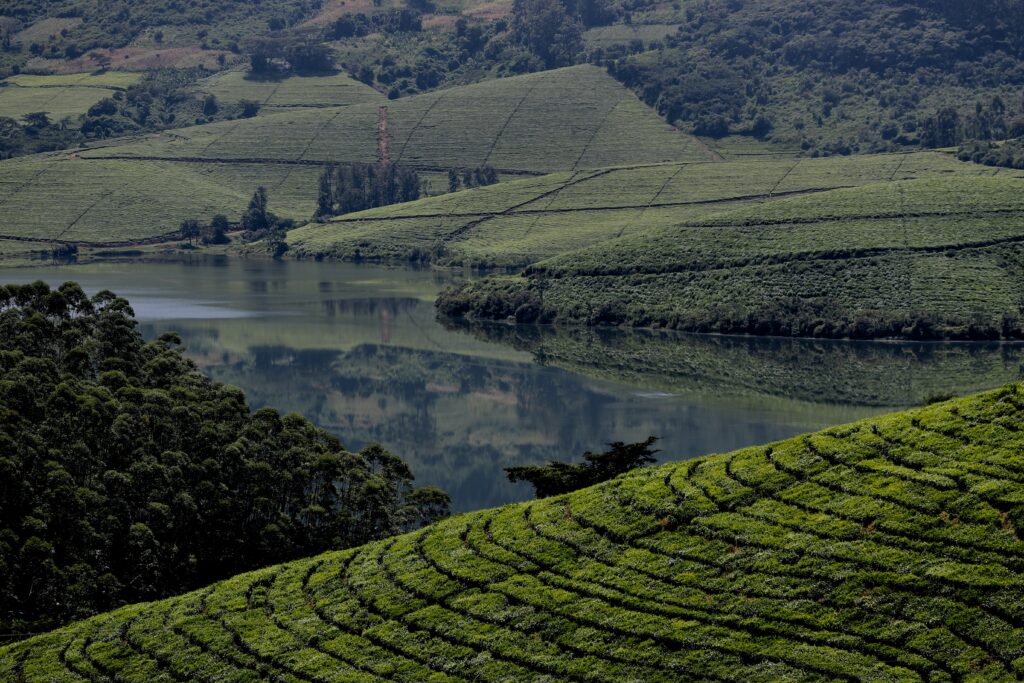
Kariba
The resort town of Kariba is the access point to the scenic Lake Kariba. While here you can take a guided tour to Observation Hill to enjoy the views of Kariba Dam. The Heights offers a marketplace for extraordinary arts and crafts and is also the home of the Chapel of Santa Barbara- a memoriam to those who died during the construction of the dam. Fishing is the big drawcard to the town where in October the International Tigerfishing Tournament takes place.
The real jewel is hiring a houseboat and traversing the length of the world’s largest man-made lake (by volume). The waters are calming and you can enjoy the rich natural vegetation as well as the wildlife that feeds on the banks. The sunsets burning the skies as well as the magic of dotted lights at night across the lake make for memorable moments. And if you’re lucky you’ll also learn about Nyaminyami, the River God of the baTonga who lives in its waters.
Khami Ruins
Khame is a ruined city, a mere 22 km (14 miles) outside of Bulawayo. This UNESCO World Heritage Site was the capital of the Kalanga Kingdom of Butwa of the Torwa Dynasty for 200 years from about 1450. This means it was occupied after the abandonment of Great Zimbabwe and was likely the capital of the successors of Monomatapa. There is a small museum to guide you.
Binga
Binga is a fishing, boating and cultural centre at the southwestern end of Lake Kariba. The town, an administrative hub was created for the Tonga people who once lived along the Zambezi river. When Lake Kariba was built in the 1950s, the Tonga people were moved relocated inland. As a result their way of life was completely overturned.
If you’re passing through from Bulawayo, Hwange or Victoria Falls stop by to visit the cultural museum. You can also support the local economy by purchasing from the plethora of handicrafts.
The town is a good place to stock up on food and refreshments if you’ll be chartering a houseboat or going on a fishing holiday on Lake Kariba.
Chirundu
Chirundu is a border town between Zimbabwe and Zambia. It’s also a favourable tiger fishing and boating spot. The views from the surrounding hills are spectacular, while wildlife is rich in the area. Elephants are regularly seen in the urban area. Chirundu is well known for the elephants who drink from the swimming pools.
Most of the fishing that happens here occurs on the Zambezi River while the town is the starting point for canoe safaris along the Zambezi River to Mana Pools and beyond.
Accommodation is abundant although you’ll also find fishing camps which offer fishing boats for hire.
Fishing
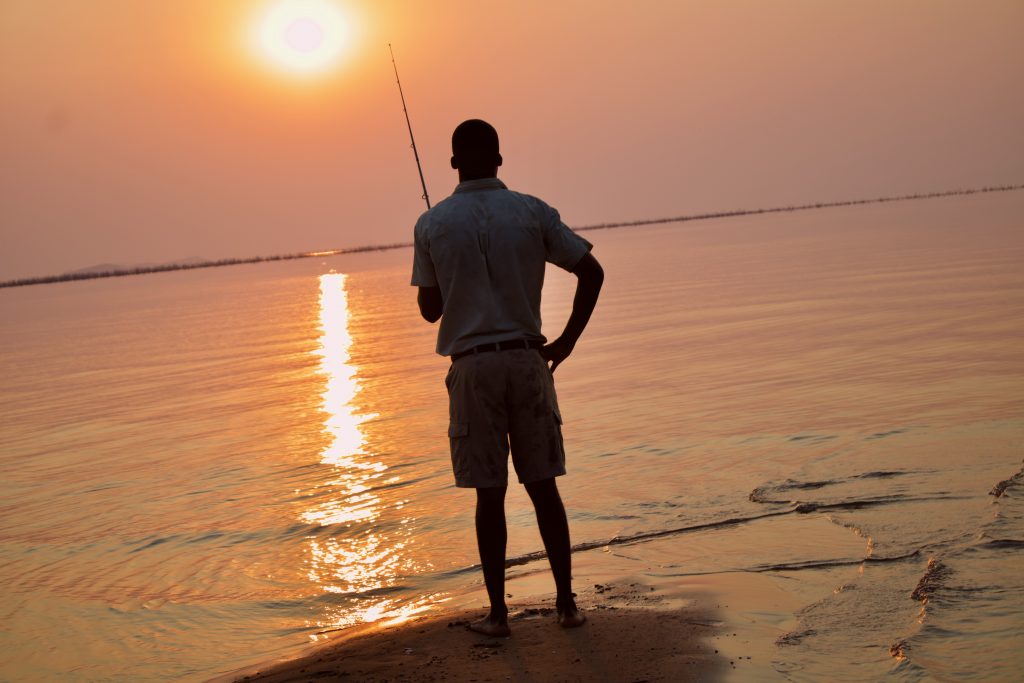
Kanyemba
Kanyemba is another small border town situated on the banks of the Zambezi River where Zimbabwe, Zambia and Mozambique meet. It’s loved by fishing enthusiasts and is the end-point for canoe safaris from Chirundu. There are a few fishing lodges available but please be warned that hunting also takes place in this region in the Dande Safari Area.
Chewore
Fishing in Chewore, in the extreme north-eastern region of Zimbabwe, is ideal offering Tigerfish, bream, catfish, bottlenose, Cornish jack, Chessa, and Nkupe. Please be warned that Chewore remains a hunting area with a number of hunting lodges.
Msuna and Deka Drum
Msuna and Deka Drum are remote fishing villages located along Lake Kariba. There are a number of fishing lodges and chalets as well as camps.
Mongwe
Mongwe is a community of 21 privately-run fishing camps and nine public campsites situated on the Zambezi River between Chirundu and Mana Pools.
The camps lie within the Hurungwe Safari Area, Nyakasanga section, where hunting concessions are active, but the land is privately-leased from the Zimbabwe National Parks and Wildlife Authority under a non-hunting agreement.
The benefit of this is that the community works towards the sustainability of the fauna and flora in the area.
Self-drivers should note that because this road passes through a hunting area, visitors are not allowed to enter it without first obtaining a permit from the Zimbabwe Parks and Wildlife Office at Marongora (at the top of the Zambezi escarpment), or at Chirundu. Permits for entry, fishing, and boating are all issued from these offices. If you fail to obtain one in advance you’ll have to pay a hefty fine.
Adventure
Zimbabwe’s National Parks
Did you know it also has some of the most abundant wildlife in Africa? The country is home to over 20 national parks and reserves that are open to tourists. You can take a guided safari through any one of them or explore on your own.
If you’re looking for a more relaxing vacation experience, Zimbabwe has several large lakes where you can go swimming or boating right off the beach at sunset. From lush vegetation to incredible wildlife and even caves to explore, these parks have it all.
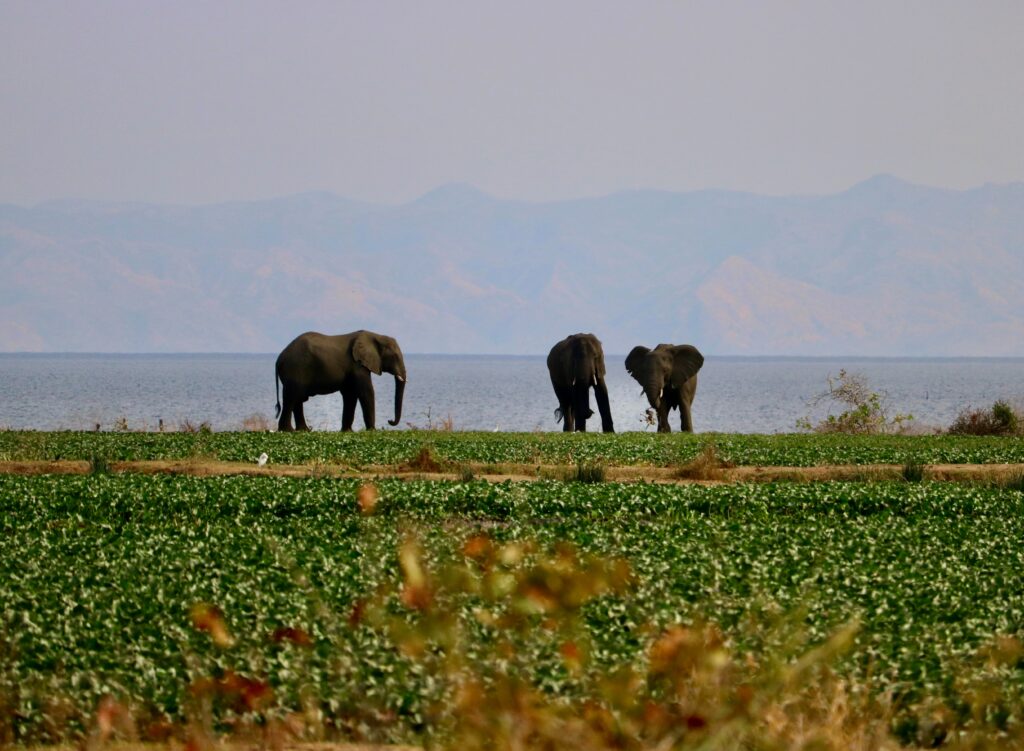
Kazuma Pan National Park
Kazuma Pan National Park is located in the northwest region of Zimbabwe on the border of Zimbabwe and Botswana. Known as the migration corridor because of mass migrations of game from September to November, it is an unspoiled wilderness. It’s famous for its large population of buffalo and elephants while its large Baboon trees attract cheetahs, wild dogs, lions, spotted hyena, zebra, sable, and the rarely seen gemsbok. Just as exciting is the commonplace occurrence of the orbit, an antelope not seen anywhere else in the country. Twitchers will also love this place.
The park is closed in January and February in the wet season as the rain makes the roads impassable.
Only two groups of visitors (up to 10 people per group) can stay in the park at any given time as there are only two campsites available in the park at Insiza Camp and Kasetsheti Camp. The campsites each have bush toilets, braai points, and water supplies.
Matobo National Park
On the outskirts of Bulawayo is the Matobo National Park, a Unesco World Heritage Site. The national park forms part of the Matopos Hills (meaning ‘bald heads’ and named by King Mzilikazi, founder of the Ndebele nation). They are well known for their alleys and precariously balanced granite rocks. The hills were formed over a million years ago and Stone Age sites have been found here, dating back more than 13 000 years. There are also shrines dedicated to the worship of God and today, it is still one of the most powerful places of Mwali religious worship. There are seven caves open to the public, where rock art by Bushmen can be found and on Malindidzimu (“the hill of benevolent spirits”) is the grave of imperialist and colonialist, Cecil John Rhodes. King Mzilikazi is also buried in the area but his grave is out of bounds for viewing.
National Park headquarters at Maleme Dam has horse stables, accommodation, and a general shop. This is the starting point for most of the National Park hikes and horse rides. While on safari here, you can spot white and black rhinos, giraffes, zebra, and leopards.
Mana Pools National Park
Mana Pools National Parks is easily one of my favourite places in Zimbabwe. It’s wild, peaceful and majestic with its rugged mountain views, flat lands, and wildlife all opening up to the mighty Zambezi River. In summer, the sun beats relentlessly but the sunsets are as if God’s own hand is painting in the sky. In winter, the leaves drop and we watch as the elephants, wild dogs, lions, kudu, and eland walk to the river.
If you’re a photographer, this World Heritage Site calls to you. But if you’re looking for a break from the maddening crowd, you’ll love the walking safaris, game drives and canoe rides along the river watched on by elephants and hippos. Twitchers are especially drawn to the area’s vast birdlife, where the day breaks with the calls of the Cape Dove.
Where to stay: There are a handful of safari lodges, eco-friendly tented or mobile camps as well as 4 self-catering Park chalets and a 5-unit tented camp. Camping on the banks of the Zambezi River is a feature of the Mana experience. None of the camps, private or public are fenced, which means wild animals are free to roam. Nighttime can be a particularly thrilling event.
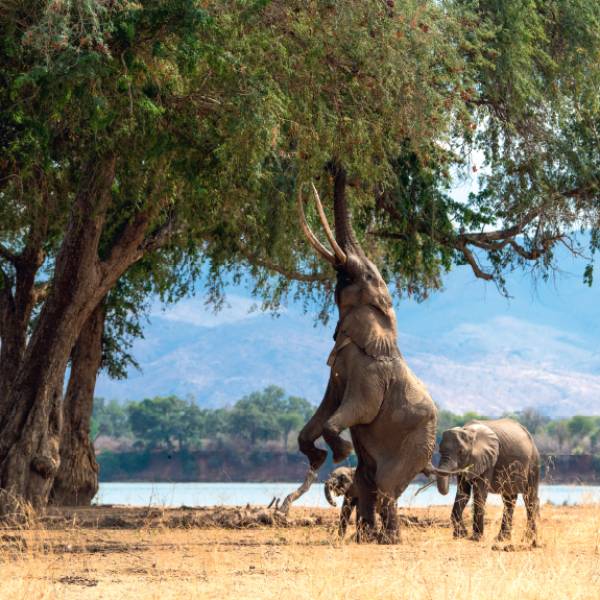
Chizarira National Park
The spectacular Chizarira National Park is located in southwest of Lake Kariba. Remote and rugged with mountainous vistas, the park is home to rich birdlife among them the Angola pitta, Livingstone flycatcher, and Taita falcon. It’s the perfect wilderness experience for hikers. Access is limited to 4X4. The Zimbabwe Parks Authority has basic camping accommodations in the park.
Matusadona National Park
Matusadona National Park is an Intensive Protection Zone located on the southern shores of Lake Kariba. Remote and rugged, it’s also a wildlife haven for elephants, buffalo, lions, hippos, leopards, cheetahs, zebra, and the endangered black rhinoceros. It’s one of the few parks that has all the big five. Many of the animals rescued from the rising waters of the newly-formed Lake Kariba were released into the park during Operation Noah in 1958. With over 240 species of birdlife you can spend several days game viewing and birdwatching while also making time for fishing on the lake shores.
There are no shops in the park, electricity supply is usually by generator, and although cellphone networks are available, the signal can be erratic.
Where to stay: Accommodation choices, in addition to chartered houseboats, vary from private luxury safari lodges and tented bush camps to basic self-catering accommodation and camping.
Zimbabwe Parks Authority offers an exclusive nine-bed lodge along with the Tashinga campsite.
Gonarezhou National Park
Gonarezhou National Park is Zimbabwe’s second-largest park. The name Gonarezhou means “place of the elephants”. The Mahenye community (Shangaan ethnic group) once called this place home but it became a place of great human and animal conflict with thousands of elephants poached. The Mahenye were driven out but soon returned. Peace reigns now and the once-traumatised elephants, kudu, nyala and bushbuck are slowly trusting humans again.
Gonarezhou is also a birdwatcher’s paradise with more than 450 species. For a delightful treat, transcend the Chilojo Cliffs, a smaller version of the USA’s Grand Canyon. Up in the sky watch as an African harrier hawk floats in the sky and back on the banks of the Save River enjoy sundowners as you watch the sunset.
Hwange National Park is the largest park in Zimbabwe and the country’s premier wildlife destination. It’s well known for its elephants (also home to the Presidential Elephant herd made famous by Alan Elliott) and is the best place to see lions in the wild. Cecil, the lion killed in 2014 by a hunter was from this area. A game drive see changing landscapes from savannah to teak forests and mukwa trees and hard sand to riverbed sand. Hwange has one of Africa’s viable wild dog population and good populations of the brown hyena and gemsbok. You can spot zebra, steenbok, kudu and a variety of birds and my favourite, the sable.
Most operators run organised tours. For self-drive visitors, 4X4 is essential as the roads are challenging to drive.
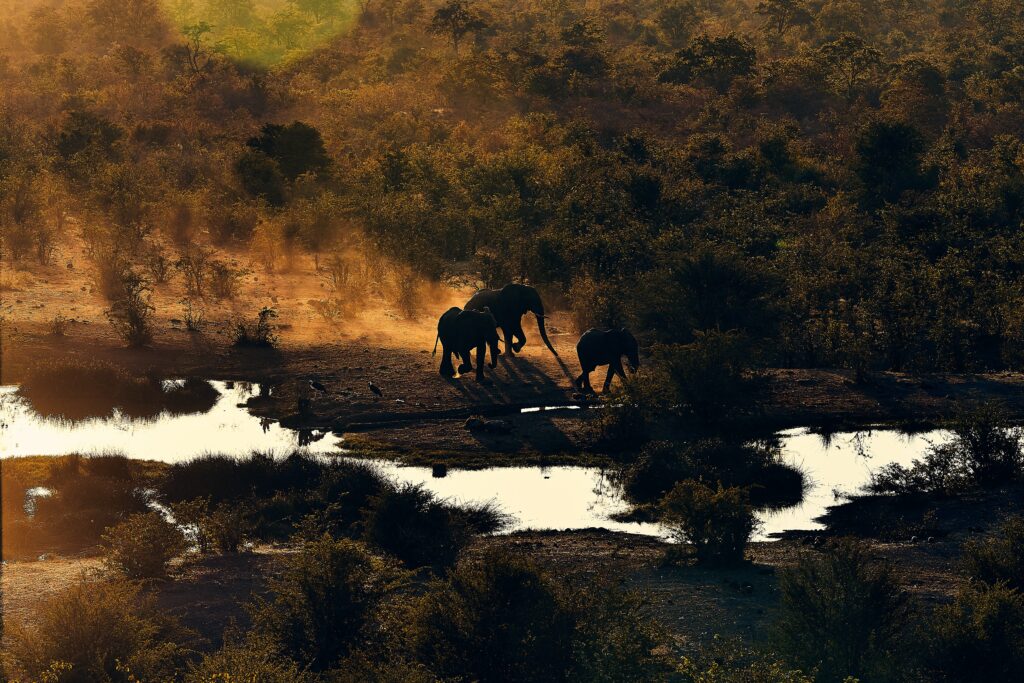
Nyanga National Park
Nyanga National Park was once the private estate of colonialist Cecil John Rhodes who is buried in the Matobo Hills National Park. The park is home to beautiful waterfalls, pine forests with astounding mountain views. This Eastern Highland region is considered one of the majestic areas in the country.
You can enjoy rafting and kayaking on the Pungwe River as well as fishing, boating, hiking and horse-riding.
The Ziwa Archaeological site has a museum with guides who can show you remnants of an ancient civilisation from the iron age.
Zambezi National Park
The Zambezi National Park is comprised of forty kilometres of the frontage of the mighty Zambezi River with rich vegetation and birdlife. A game drive brings sights of buffalo, elephants, giraffes, zebras and a myriad of antelope. It is also possible to spot lions and leopards. The park is conjoined with the Victoria Falls National Park. You can also go on a walking safari in the company of a professional armed guide.
On his way to discovering the Victoria Falls in 1855, David Livingstone travelled down this section of the Zambezi, from the Linyanti Swamps in neighbouring Botswana. This incredibly beautiful stretch of river above the falls enchanted Livingstone and led him to write about “scenes so lovely they must have been gazed upon by angels in their flight”, a quote often mistakenly associated with Victoria Falls itself.
While you’re here learn more about the Victoria Falls Anti-Poaching Unit (VAPU).
Chinhoyi Caves Recreational Park
The Chinhoyi Caves Recreational Park is located 71km north of Harare and is a good rest stop on your way to Kariba. The mysterious caves are a system of tunnels and caverns that lead to the beautiful ultramarine “Sleeping Pool”. This body of water is known in Shona as “Chirorodziva”, the “Pool of the Fallen” because of the many lives lost in its depths. If you do want to spend the night in the vicinity there is a camping site and motel. However, if you are a keen swimmer or scuba diver this is a highlight on your trip.
Sapi Private Game Reserve
Sapi, together with Chewore and Mana Pools National Park make up a UNESCO World Heritage Site. Once a hunting ground, this area is being revitalised to increase wildlife and tourism. Fishing camps are dotted along the Zambezi River.
Accommodation
When traveling to Zimbabwe, it is important to know your accommodation options. With a country as large and diverse as Zimbabwe, there is something to suit every taste and budget. Whether you are looking for a luxury hotel or a more affordable option, we have got you covered.
Budget Accommodation
The budget traveller can find several hostels and guesthouses in the primary towns and cities that offer clean rooms with shared facilities. You will also find many hotels outside of Harare and Bulawayo that have similar amenities at a lower price.
Depending on the season, a bed in a dorm with multiple beds mixed gender costs US$20-US$40 per night. A private room in Harare with a double bed costs $50-US$90. Free wifi is standard, and many hostels and hotels also include free breakfast and/or have a kitchen. Accommodation in the more popular tourist areas comes at a premium. For example, in Victoria Falls you can expect to pay up to US$100 for a budget-friendly hotel room.
If you love the outdoors and are up for an adventure, then you can stay at any of the numerous camping sites in the country. You will find most camping sites within the national parks or reserves. You can expect to pay under US$10 for one night per person.
Mid-Range Accommodation
Mid-range travellers will also find plenty of options. For example, you could rent an apartment through Airbnb or book a room at one of the many boutique hotels in the country. Booking a homestay is also a viable option. These properties typically offer more space and privacy than hostels or guesthouses but less than luxury hotels. The cost is usually US$200 a night with free wifi and breakfast.
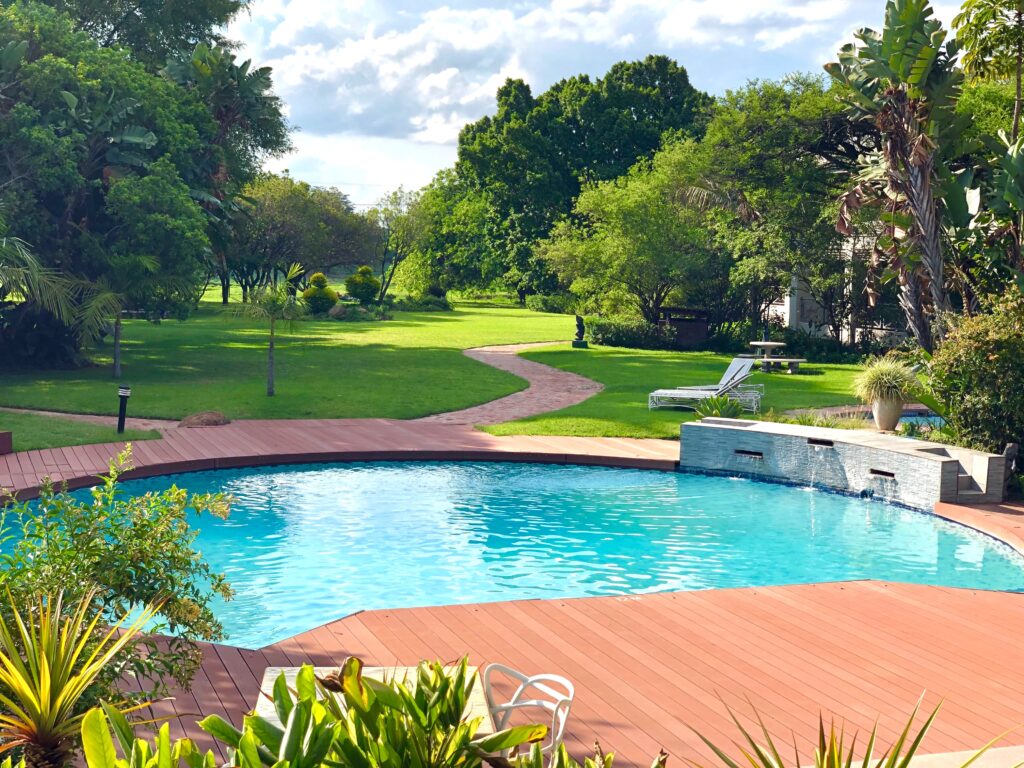
Luxury Accommodation
Luxury accommodation is the most expensive option and includes top-of-the-line amenities like pools and spas. These are great if you’re looking for an all-inclusive experience where everything is taken care of for you—but they come with an equally steep price tag of around US$400 per night. The price tag can run into the thousands. Additionally, most people visiting Zimbabwe are there for wildlife experiences, therefore the safari lodges while well-equipped can be costly. A night at the Victoria Falls River Lodge costs just over US$1000 for one person while a night at a villa at Singita Pamushana can run in the tens of thousands.
Houseboats
Zimbabwe is home to Lake Kariba, the world’s largest man-made lake, and the Zambezi River. These bodies of water offer a plethora of activities for visitors, such as fishing, swimming, and boat tours.
There are a number of companies that offer houseboat rentals in Zimbabwe. These rentals are typically full-equipped and come with a staff that will take care of your every need. This allows you to relax and enjoy your trip without having to worry about the logistics.
Houseboats that you can rent include:
- Zambezi Drift’s Peregrine
- Mirimba Houseboat
- Power Sails
- Baobab
- This Is It
- African Dream
- Sahwira Leisure
- Umbozha
- Karabezi
Food
Zimbabwe is home to a wide array of dishes from all over Africa. You can expect to find anything from curries and stews, to breads and rice, as well as plenty of local specialities. While you are travelling around Zimbabwe, give the local delicacies a try. I’ve seen people squirm and shy away from trying new foods, but you really can’t visit someone’s home and not enjoy their food hospitality.
Bota
This is a porridge made from sorghum, millet or maize meal mixed with water to a thick pouring consistency. It’s usually flavoured with margarine, salt, sugar or peanut butter. Some do add cream or milk for a delicious version.
Sadza
You make sadza similarly to bota although using less water to create a stiff porridge that is usually eaten with the hands. There’s not a specific taste to sadza. Some people choose to flavour the water with salt before adding the maize meal, sorghum or ground millet. Sadza is usually served with relish, vegetables and meat.
Mopane Worms
These are caterpillars which feed off the leaves of the mopane trees. They are a delicacy in many Southern African countries. The worms are cleaned and the innards removed then they are fried with onions, tomatoes and spices.
Mutakura
This is a dish made from peanuts, maize, bambara nuts, cow peas and sugar beans. You speak the ingredients overnight and then boil for several hours. Mutakura can be eaten for breakfast, lunch or supper.
Umxhanxa
One of my favourite dishes when I was growing up. My neighbour’s mom always served this hot. It’s a dish of maize kernels, sugar and yellow watermelon. It has a sweet but comforting taste and is great for a winter’s lunch.
Madhumbe
This root vegetable also known as yam is usually boiled and eaten for breakfast. It can also be fried.
Mazondo
This iconic dish of cow heels is boiled until soft and seasoned with salt, pepper and garlic for a heart addition to sadza.
Kapenta
These tiny freshwater fish are a staple in many Zimbabwean homes. They are usually sun-dried when sold but are then cooked with onions, tomatoes and peanut butter.
Nhedzi
Nhedzi is a soup made from wild mushrooms that’s served with bread.
Tilapia
Tilapia is often fried and served with relish as a main meal.
Whawha
Whawha is a traditional beer made from fermenting maize and sugar. The result is a sour cloudy drink that can be quite potent. I have enjoyed it with additional sugar.
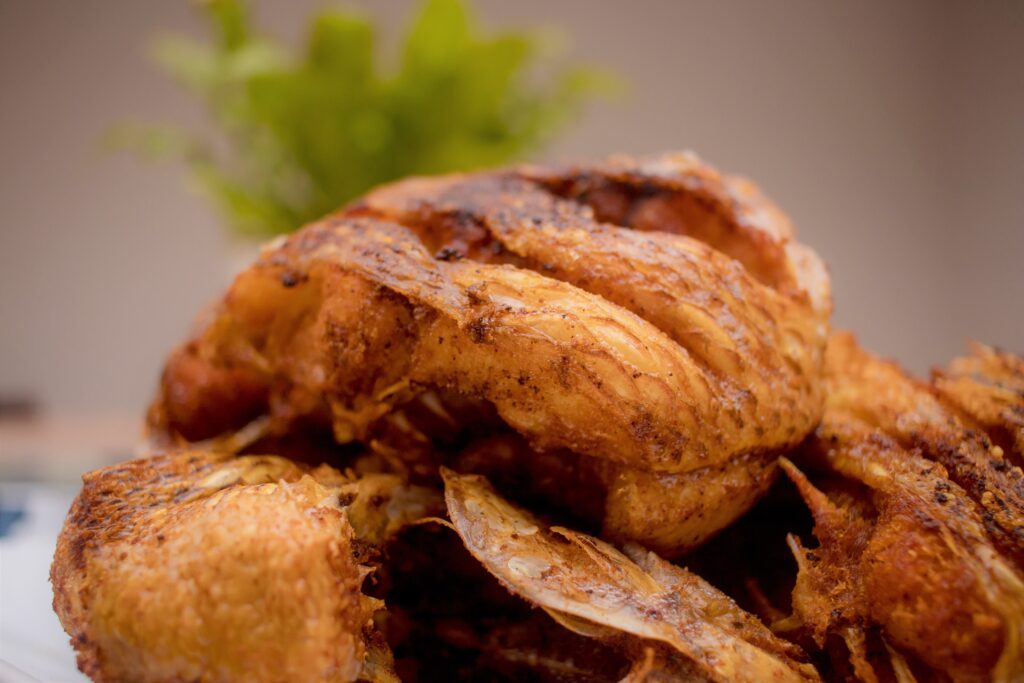
How to get around
Road, air and rail are your best options when you travel around Zimbabwe. Most package holidays will include transfers to your various destinations around the country, although this can be expensive, especially if you are using charter planes. In many cases, a charter flight or bush plane may be the fastest and most convenient way to reach your destination.
You have arrived at the airport. What now?
Again, if you have booked a packaged holiday your accommodation will, most likely, have arranged a shuttle to transport you from the airport. If you have not booked a packaged holiday, you may contact your accommodation before you travel and request a shuttle.
Taxi
Alternatively, you can book a taxi before you travel or you can make use of the various taxis that are in abundance at the airport. I encourage you to phone your hotel and get advice on using taxis before you travel.
Air
There are a number of flights that connect the larger cities and towns to the tourism hotspots. From Harare, Bulawayo and Victoria Falls you can catch flights to your destination seamlessly.
On my way to Kanga Camp in the Mana Pools National Park, I used the Safari Logistic Service (run by African Bush Camps). A guide waited for me at the airport as I disembarked in Harare and led me to the domestic terminal where our plane was waiting.
There are affordable flight services you can use to travel domestically, although charter flights to safari lodges and bespoke destinations can be on the pricey side.
Road
There are a number of shuttle companies that you can use to travel from city to city. They are also reliable if you are interested in specific tours.
On the other hand, for a more immersive experience, you may want to drive yourself around. You can either hire a car when you arrive in Zimbabwe or you can choose to drive your private car into the country. I recommend driving a 4X4 if you will be going to the national parks on safari.
Car hire
Zimbabwe accepts valid driver’s licenses from SADC countries but if you are from a non-SADC country you may use your driver’s license from your country of origin for a period of up to 90 days. Driver’s licenses that are in a non-English language must be accompanied by an International Driving Permit, which you can apply for at an Automobile Association centre.
Fuel (diesel and petrol)is available in major towns and border posts and may be purchased in US$. Visitors may use foreign credit/debit cards or fuel cards to buy fuel. If you can, make sure you buy extra fuel, especially if you are going to remote areas further inland. Be prepared for long queues when buying fuel and you may experience fuel shortages in some places. Please be patient.
When driving into Zimbabwe please remember there is the minor red tape you’ll need to work through in order to bring a foreign car into the country. You’ll also pay Carbon Tax as well as a Road Access Fee and a Commercial Vehicle Guarantee if you have a 4X4.
Rail
If you are looking for a rather romantic way to travel between cities then perhaps try the National Railways of Zimbabwe.
The British-built coaches from the 1950s may not exactly inspire modern luxury but they offer a relaxed albeit exciting adventure. First-class tickets are ten times cheaper than a flight ticket (as little as Z$30) and for a little extra you can get bedding for the long journey on the tracks. If you’re interested you can read about other travellers’ journeys here.
There are train services between:
Harare-Bulawayo-Harare
Bulawayo-Victoria Falls-Bulawayo
Harare-Mutare-Harare
Bulawayo-Chiredzi-Bulawayo
Please remember that reservations and payments can only be made on the day of travel at any train station.
Ferry
Kariba Ferries links Kariba Town to Victoria Falls, transporting passengers and vehicles between Kariba and Mlibizi on an overnight journey of 22 hours.
Stops include Rhino Island, Bumi Hills, Kota Kota Narrows, and Chete Gorge. On the journey, you can enjoy meals, snacks, and beautiful natural views. It’s not a luxurious vehicle and markets itself as a simple ferry service but still, the trip is enjoyable and comfortable.
Visa requirements for Zimbabwe Travel
There are three types of visa protocols to enter Zimbabwe:
Category A
Visa-free entry into Zimbabwe: citizens of most SADC countries do not need visas to enter Zimbabwe.
Canadian passports: Single entry only: US$75
British and Irish passports:Single entry: US$55 (or equivalent in SARands or Pounds); Double entry: US$$70.
Other passports (USA, Europe, Australia, New Zealand): Single entry: US$30 (or equivalent in SA Rands or Pounds); Double entry: US$45 (or equivalent).
Category B
Visa on arrival at the point of entry: visitors do not need to apply for a visa before travelling and may obtain a visa on arrival for a fee.
Category C
Some visitors must ensure a visa before travelling to Zimbabwe so they must apply online.
Best time to travel to Zimbabwe
While Zimbabwe has a generally lovely, temperate climate, the dry season (April – October) is usually the best time to visit, especially if you want to go on a safari or visit Victoria Falls. During this time, the temperatures can dip to the low single digits in the mornings and evenings as April marks the end of summer leading to the cold winter months of June and July. The temperatures start to rise from August into late October when they can go as high as 40°C, especially in the Mana Pools National Park.
With little rain, the animals gather at the watering holes making for fascinating viewing and with the start of spring many babies are born in the wild.
The wet season (November – March) brings torrential afternoon rains and high humidity. The driving conditions in the parks can be challenging and the rich vegetation makes it difficult to spot animals in the parks although this is the best time to see baby animals. From November to December, the Zambezi River is at its lowest, which means Victoria Falls is not at its best.
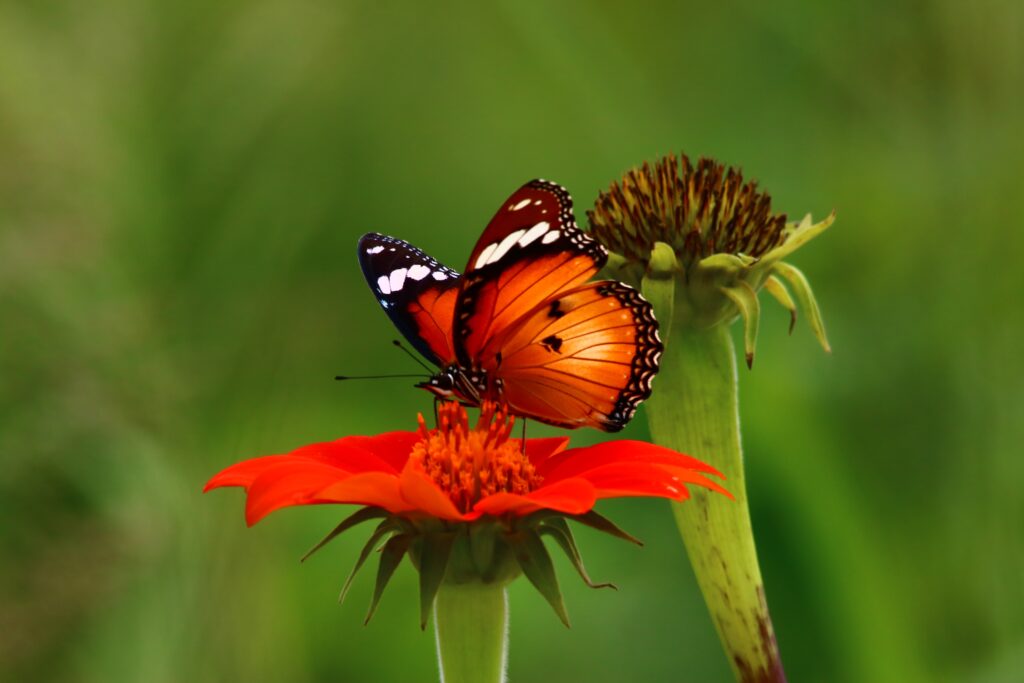
Travel tips and hacks
People are often overwhelmed by the political insecurity portrayed in the media and falsely believe that there are riots and revolts everywhere.
I grew up in Zimbabwe, and have found Zimbabweans to be some of the friendliest, warmest people anywhere. The situation is dire for many people in the country, especially with the onslaught of Covid-19. It is true that people are calling for economic and political change and demonstrations can occur. However, most tourist areas are away from any protests.
I feel safe whenever I am in Zimbabwe. But as with travel in any other country you must exercise some caution. As much as you may be enjoying the sight and sounds of the cities or towns, you must walk with purpose.
Learn a few words of Ndebele and Shona. English is widely spoken so it’s not necessary to learn Zimbabwean languages but people will appreciate it.
Zimbabweans are truly kind and generous people. They are always on hand to help you or share a story or meal so if you can support a local business while you are travelling, please do so.
I am a huge fan of trying a country’s beer as soon as I arrive at my destination. While in Zimbabwe, have a chilled Zambezi Lager, Golden Pilsener or Bohlingers. These are light, crisp beers. If you’re more adventurous, give the sorghum beer, Chibuku Shake Shake a try.
